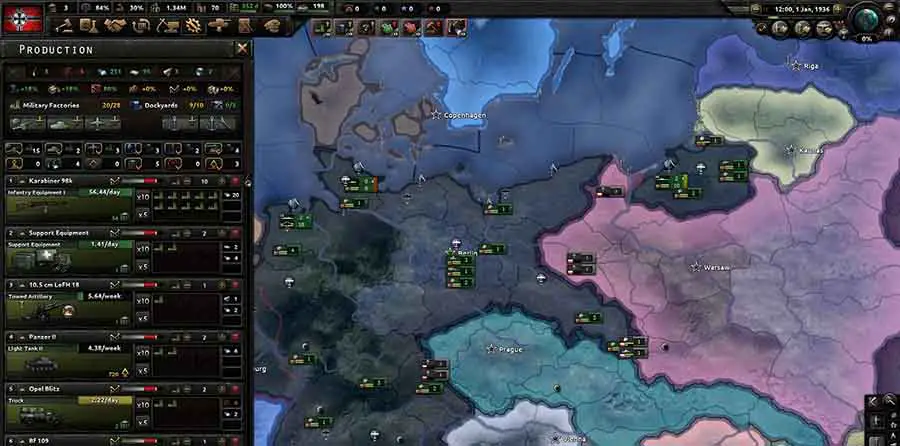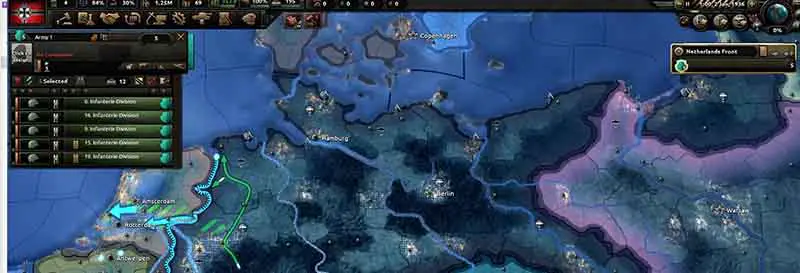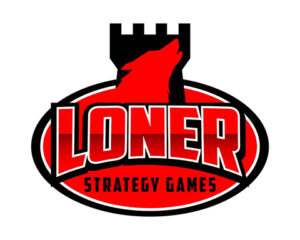
Hearts of Iron for is a wargame set in the World War II era. It’s grand strategy wargaming at its best but it’s tough to know just exactly how to start. It can seem overwhelming but it’s not.
Taking care of the alerts at the top of the screen is what you should do first in Hearts of Iron IV after selecting the starting year and country you want to play. Start by filling up empty research slots and giving your civilian and military factories something to produce.
This article is only one of many ways to start a game of Hearts of Iron IV but as a beginner I found these options worked the best for me.
Select the Starting Year
There are only two choices, 1 January 1936 or 14 August 1939. The biggest difference is that if you start with 1936 you have a little time to modify the composition of your starting armies and maneuver them into position. With 1939 you essentially jump right into the war and take what the game gives you in armies and starting positions.
Select Your Country
What’s the best country for a beginner? Probably Russia or Germany. They get into the war right away without having any outlying territories to worry about and have plenty of firepower and research options to play with. Italy might be good if you like Naval stuff. I liked Germany since they’re the ones who started it all plus, they have four research slots while Russia only has three.
Choose The Difficulty Level
When I’m learning a game, I like all the advantages I can get so I’ll usually start on the easiest difficulty setting I can find, which for this game is Civilian. This gives you all kinds of bonuses, like reductions in supply consumption and a research speed bonus of +15%. Leave custom rules alone until later.
Take Care Of The Alerts
Like almost all Paradox games there will be a row of alerts at the top of the screen and taking care of them is one of the better ways to ease into the game. Not only should they be taken care of quickly they also help you learn the game. The alerts I talk about below aren’t necessarily the ones you will get in any given game, nor will they always be in this order, but odds are you’ll get most of them. The important thing to remember is that they are important and need to be taken care of. As you learn the game, you’ll start realizing which ones you can safely ignore, or at least put off until later.
Fill The Research Slots
One of the first alerts will tell you there are open research slots available and depending on your country you will have from 2 to 4. The best idea at the start of the game is to improve research and production speed which improves efficiencies at building all the other stuff. It’s best to get that increased as much as possible before you are forced to divert resources to the war effort.
Since I have Germany, I have the luxury of choosing the one Engineering item that wasn’t ahead of its time, Electronic Mechanical Engineering for its 3% bonus in research speed and still have three research slots left. Atomic research was available but that was four years ahead of its time which carries a significant research speed penalty. It’s better to wait on that one until it’s closer to 1940.
I also had the luxury of researching both Industrial options that were available without any penalty and still have one slot left over to research something along the military lines. I chose to research Basic Machine Tools which raises the production efficiency cap by 10% and Construction 1 which gives a 10% bump in both construction speed and factory repair speed.
I thought it would be good to give my infantry units some support, so I started researching Maintenance companies to help keep my units in tip-top fighting condition.
Assign Work To Free Civilian Factories (Alert)
This alert is telling you that not all your civilian factories are at work producing something. Some are producing consumer goods, which is a fixed number that can’t be changed unless you change some laws, so all of them won’t be available.
Clicking on this alert will open the Construction screen. Just like research I like to focus on things that will give me a bonus in the long run like infrastructure and factories before the war starts. The first thing I like to do is build more civilian factories to build up my industrial base so I can build more stuff faster later. I build them where infrastructure is the highest percentage so the supplies they produce can be moved faster.
And since a country depends so much on Infrastructure, I also assign some factories to improving that as well. Factories will give priority to the first item in the list, so the order construction items are listed in is important. Put what you want built first at the top of the list.
Assign Production To Free Military Factories (Alert)

Just like civilian factories, some of your military factories will be at work but not all of them. Unlike civilian factories they are all under your control. I’m a big believer in establishing air superiority as quickly as possible but I didn’t like the penalties for being short on rubber so early in the game, so I left that factory set to one for the time being.
I decided Towed Infantry would be good thing to have as long as I didn’t exceed my Tungsten supply so I bumped up my support equipment just a little bit so that it took advantage of all the Tungsten I had available. I figured I could start getting rubber through trade and then increase my fighter production later.
Assign Work To Free Dockyards
I worry more about land stuff in the early game, so I simply assigned another dockyard to producing submarines to take care of the alert. Use this link to learn more about Naval Warfare.
Set a National Focus (Alert)
A National Focus is simply a path your country takes that provides perks. It’s similar to research except that the only investment is time. The tree will vary quite a bit depending on what country you play. As Germany I had the option of focusing on the Rhineland which would demilitarize the Moselland and Rhineland and give me a boost of 120% in political power and an army experience gain of 5% while increasing world tensions by 5%. After that Focus is complete another one becomes available that is mutually exclusive, I can either befriend China or Japan, but not both.
There are several options available for Germany, but I liked the Four-Year Plan because of the initial research bonuses it gives plus I gain access to a Political Advisor who, if hired, gives a 10% bonus to infrastructure construction speed, civilian factory construction speed, railway construction speed and refinery construction speed.
You get even more bonuses to construction speeds as you progress down this Focus Tree, plus you gain more building slots and another research slot.
There are always rush tactics so choosing something like Air Innovation might be a good choice instead but since I’ve never played that type of game yet game I can’t say for sure, at least not until I’ve tried it.
No Divisions In Basic Training Alert
Clicking this alert opens the Recruit and Deploy screen. Once opened you’ll have several templates to choose from for training. I like strengthening my land forces in the beginning, so I selected Infantry units. To start training a unit click on the Train button on the unit template which adds it to the Deployment queue.
In the Deployment queue you can set the number of units you’d like to train, how many times you’d like to train that number of units and where to deploy them once they reach 100% training. If there is an urgent need, they can be deployed sooner but at a reduced operating strength.
To increase the number of units to train click on Add Unit. I decided I wanted to train 10 infantry units and deploy them to Brandenburg. They won’t start training until they have everything they need so if there is a critical shortage of something now is the time to go back and tweak your military factory production.
Trades are in eights and each group of eight takes one civilian factory to trade for it.
Unassigned Divisions Alert
This means you don’t have at least some of your divisions assigned to an army. While creating armies you can do a lot of things, like move divisions around and create battle plans for your armies. The easiest way, at least for me, to create an army is to click and drag around some units. At the bottom of the screen will be two blank portraits with plus signs in them, click on the portrait on the right to create a new army.
A panel will appear with a theater name in it, which is just a simple way to keep track of things if you rename it. Since the divisions I created are along the Netherlands border I renamed their theater the Netherlands Front. This makes it a little easier to keep track of armies as things get more complex in the game.
Assigning Orders to Armies
While you have the new army selected there are several things you can do that are a good idea. Almost any newly created army will benefit from training. You can start training from the Battle Plans panel which is at the bottom of the screen. They can be exercised to gain some experience points for the onslaught that is about to begin. While training they will use up some supplies.
Since this is a wargame it’s also a great idea to set up a front line and an actual battle plan and all this is still done using the Battle Plan panel. Since, at least in this game, I’m planning to attack the Netherlands I made my frontline the border between Germany (me) and the Netherlands.
Creating a Front Line
Creating a front line is easy. If your army isn’t selected, left click on it and the Battle Plan panel will become visible if it isn’t already. Toward the middle of the Battle Plan panel there is a button you click to start setting up a front line (hovering over an icon will bring up a tool tip describing what the icon does). Once that button is clicked simply click on the border of the country you want to create a front line for. There are ways to customize a front line, but this article is getting too long already, I’ll probably cover it in another article when I can, along with battle plans.
Assigning Generals
There should always be a commander assigned to an army for the bonuses. Generals are always assigned to armies and most of them can only handle 24 divisions without incurring a penalty. The existing armies will be the portraits without a plus sign in them at the bottom of the screen. Clicking on one of them will open an organizer, normally in the upper left corner. This lists all the divisions in the army plus it will tell you there is no Commander assigned if one hasn’t been assigned. Click on the empty portrait in the outliner and a list of available Generals will appear. Pick the one best suited for the army and click on it to assign him to the army. You’ll notice that the portrait that was originally blank will now have the Portrait of the newly assigned General.
Assigning Field Marshals
Field Marshals can give bonuses to up to five groups of armies. One way to create an army group is to select the armies you want in the army group by shift clicking on them and then click the create new army group icon. After it’s created a Field Marshal can be assigned the same way as assigning a General to an army. Click on the newly created army group icon and in the outliner click on the blank portrait. A list of Field Marshals will appear, select one to assign him to your army group.
Insufficient Resources
Since I’m a little bit of a perfectionist I like to take care of this alert if I can although some players tend to ignore it at the start of the game. You can ignore it by right clicking on the alert to make it go away.
Left clicking this alert will open the Trade screen. This screen will display resources and any you are short of are displayed numerically in red. Clicking on an item will bring up a list of all available countries willing to trade for that resource plus it will display how much they have available and whether convoys are needed or not.
Trades are in eights and each group of eight takes one civilian factory to trade for it. You are in effect trading the production of one civilian factory for whatever it is you want to import eight of. This reduces the number of civilian factories building structures used in producing things like more civilian factories and infrastructure improvements. So, trading effectively slows down things like building more civilian factories and infrastructure. Those items build more slowly because you have less factories dedicated to that since they’re trading for foreign goods instead. But if acquire scarce needed resources your military production will get better and faster so it’s a trade-off.
Since my long-term plans include air superiority, I decided the tradeoff was worth it and dedicated one civilian factory to trading for rubber. Since I only need 5 I’ll effectively be wasting 3 units of rubber since I can’t stockpile anything but fuel so going back and tweaking my military production to take advantage of the 3 additional rubber makes sense.
Don’t forget to visit my YouTube channel at https://www.youtube.com/channel/UCcWU6qxVisK93h5guKRVtdg
If you want to learn how to play Hearts of Iron 4 really well, I’d recommended watching this series of videos from Quill18. There are 7 in total but if you don’t watch them all then you’ll find the first 3 to be the extremely beneficial.
